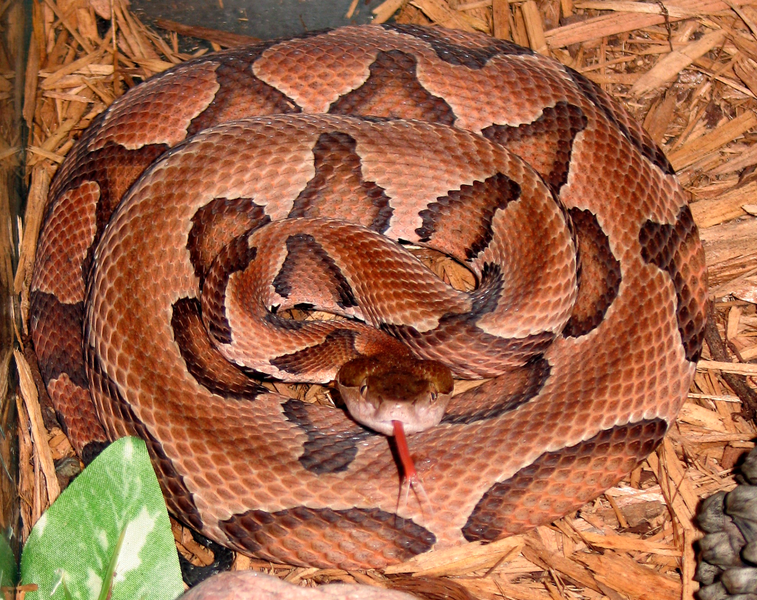Hello ladies and gents this is the Viking telling you that today we are talking about
Agkistrodon contortrix aka Copperhead Snake
Adults grow to a typical length (including tail) of 50–95 cm (20–37 in). Some may exceed 1 m (3.3 ft), although that is exceptional for this species. Males are usually larger than females. Good-sized adult males usually do not exceed 74 to 76 cm (29 to 30 in), and females typically do not exceed 60 to 66 cm (24 to 26 in). In one study, males were found to weigh from 101.5 to 343 g (3.58 to 12.10 oz), with a mean of roughly 197.4 g (6.96 oz).
According to a different study, females have a mean body mass of 119.8 g (4.23 oz). The maximum length reported for this species is 134.6 cm (53.0 in) for A. c. mokasen (Ditmars, 1931). Brimley (1944) mentions a specimen of A. c. mokasen from Chapel Hill, North Carolina, that was "four feet, six inches" (137.2 cm), but this may have been an approximation. The maximum length for A. c. contortrix is 132.1 cm (52.0 in) (Conant, 1958).
The body is relatively stout and the head is broad and distinct from the neck. Because the snout slopes down and back, it appears less blunt than that of the cottonmouth, A. piscivorus. Consequently, the top of the head extends further forward than the mouth.
The scalation includes 21–25 (usually 23) rows of dorsal scales at midbody, 138–157 ventral scales in both sexes and 38–62 and 37–57 subcaudal scales in males and females, respectively. The subcaudals are usually single, but the percentage thereof decreases clinally from the northeast, where about 80% are undivided, to the southwest of the geographic range where as little as 50% may be undivided. On the head are usually 9 large symmetrical plates, 6–10 (usually 8) supralabial scales, and 8–13 (usually 10) sublabial scales.
The color pattern consists of a pale tan to pinkish-tan ground color that becomes darker towards the foreline, overlaid with a series of 10–18 (13.4) crossbands. Characteristically, both the ground color and crossband pattern are pale in A. c. contortrix. These crossbands are light tan to pinkish-tan to pale brown in the center, but darker towards the edges. They are about two scales wide or less at the midline of the back, but expand to a width of 6–10 scales on the sides of the body.
They do not extend down to the ventral scales. Often, the crossbands are divided at the midline and alternate on either side of the body, with some individuals even having more half bands than complete ones. A series of dark brown spots is also present on the flanks, next to the belly, and are largest and darkest in the spaces between the crossbands.
The belly is the same color as the ground color, but may be a little whitish in part. At the base of the tail are one to three (usually two) brown crossbands followed by a gray area. In juveniles, the pattern on the tail is more distinct: 7–9 crossbands are visible, while the tip is yellow. On the head, the crown is usually unmarked, except for a pair of small dark spots, one near the midline of each parietal scale. A faint postocular stripe is also present; diffuse above and bordered below by a narrow brown edge.
Several aberrant color patterns for A. c. contortrix, or populations that intergrade with it, have also been reported. In a specimen described by Livezey (1949) from Walker County, Texas, 11 of 17 crossbands were not joined middorsally, while on one side, three of the crossbands were fused together longitudinally to form a continuous, undulating band, surmounted above by a dark stripe that was 2.0–2.5 scales wide.
In another specimen, from Lowndes County, Alabama, the first three crossbands were complete, followed by a dark stripe that ran down either side of the body, with points of pigment reaching up to the midline in six places, but never getting there, after which the last four crossbands on the tail were also complete. A specimen found in Terrebonne Parish, Louisiana, by Ernest A. Liner, had a similar striped pattern, with only the first and last two crossbands being normal.

Comments
Post a Comment